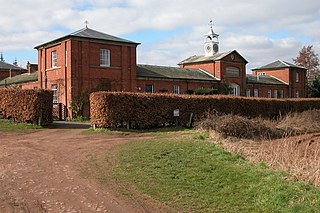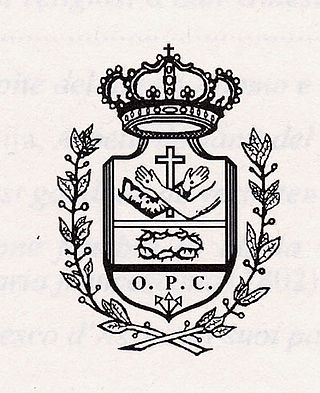Related Research Articles

The Franciscans are a group of related mendicant religious orders of the Catholic Church. Founded in 1209 by the Italian saint Francis of Assisi, these orders include three independent orders for men, orders for nuns such as the Order of Saint Clare, and the Third Order of Saint Francis open to male and female members. They adhere to the teachings and spiritual disciplines of the founder and of his main associates and followers, such as Clare of Assisi, Anthony of Padua, and Elizabeth of Hungary. Several smaller Protestant Franciscan orders or other groups have been established since late 1800s as well, particularly in the Anglican and Lutheran traditions.

A convent is an enclosed community of monks, nuns, friars or religious sisters. Alternatively, convent means the building used by the community.

The Minims, officially known as the Order of Minims, and known in German-speaking countries as the Paulaner Order, are a Roman Catholic religious order of friars founded by Francis of Paola in fifteenth-century Italy. The order soon spread to France, Germany and Spain, and continues to exist today.

Mendicant orders are, primarily, certain Catholic religious orders that have vowed for their male members a lifestyle of poverty, traveling, and living in urban areas for purposes of preaching, evangelization, and ministry, especially to the poor. At their foundation these orders rejected the previously established monastic model, which prescribed living in one stable, isolated community where members worked at a trade and owned property in common, including land, buildings and other wealth. By contrast, the mendicants avoided owning property at all, did not work at a trade, and embraced a poor, often itinerant lifestyle. They depended for their survival on the goodwill of the people to whom they preached. The members of these orders are not called monks but friars.

The Order of Friars Minor Conventual is a male religious fraternity in the Catholic Church and a branch of the Franciscan Order. Conventual Franciscan Friars are identified by the affix O.F.M. Conv. after their names. They are also known as Conventual Franciscans or Minorites.

The Society of Saint Francis (SSF) is an international Franciscan religious order within the Anglican Communion. It is the main recognised Anglican Franciscan order, but there are also other Franciscan orders in the Anglican Communion.

The Third Order Regular of St. Francis of Penance or simply the Third Order Regular of St. Francis is a mendicant order rooted in the Third Order of St. Francis which was founded in 1221. The members add the nominal letters T.O.R. after their names to indicate their membership in the congregation.
The Brothers of Penitence or Friars of the Sack were an Augustinian community also known as Boni Homines or Bonshommes, with houses in Spain, France and England.
The Church of the Friars Preachers of the Annunciation of the Blessed Virgin Mary at Wigtown, commonly called Blackfriars, was a mendicant friary of the Dominican Order founded in the 13th century at Wigtown, Galloway, Scotland. The Chronica Extracta said that it was founded by Dervorguilla of Galloway, who died in 1290.

John Forest was an English Franciscan friar and martyr. Confessor to Queen Catherine of Aragon, Forest was burned to death at Smithfield for "heresy", in that he refused to acknowledge the King as head of the church.
Abbeys and priories in Hampshire lists abbeys, priories, friaries or other monastic religious houses in Hampshire, England.
Køge Friary was a small Franciscan friary located in Køge, on the east coast of Zealand, Denmark.
Holbaek Priory was a small Dominican monastery in Holbæk, Denmark.
The Franciscan Portiuncula Friary is the oldest friary in Pakistan, founded in 1940. It is located in Gulshan-e-Iqbal, Karachi, adjacent to the Christ the King Seminary. It is the Pakistani base of the Order of Friars Minor, a mendicant Catholic religious order founded by Saint Francis of Assisi in 1209.
Austin Friary was an Augustinian friary in Bristol, England. It was established in 1313, when Simon de Montecute gave 100 square feet (9.3 m2) of land within the Temple Gate of Bristol. Further gifts of land were made by William de Montecute and Thomas of Berkeley during the next thirty years.

Blackfriars, Bristol was a Dominican priory in Broadmead, Bristol, England. It was founded by Maurice de Gaunt in 1227 or 1228. Llywelyn ap Dafydd, son of Dafydd ap Gruffydd, the last native Prince of Wales, was buried in the cemetery of the priory. Following the Dissolution of the Monasteries in the 16th century, surviving parts of the priory became a guildhall for the Smiths and Cutlers Company, the Bakers Company, a workhouse and then Bristol Quaker meeting house. In the 20th century, it has housed the local register office, a theatre company, and a restaurant.

Greyfriars, in Bristol, England, was a Franciscan friary. The name Greyfriars derived from the grey robes worn by the friars. It was founded at some time before 1234, within the town walls and then moved to Lewin's Mead in 1250. The site included extensive gardens surrounded by a stone wall. Following the Dissolution of the Monasteries in the sixteenth century, the premises were leased to the town council in 1541, who desired to use the stone to make repairs to the town walls, and the harbour facilities. In succeeding centuries many different uses have been made of the site, which is currently occupied by an office block and part of Bristol Dental School.
Whitefriars was a Carmelite friary on the lower slopes of St Michael's Hill, Bristol, England. It was established in 1267; in subsequent centuries a friary church was built and extensive gardens developed. The establishment was dissolved in 1538.
The following is a timeline of the history of the city of Bristol, England.
References
- ↑ Pastscape
- 1 2 3 Gasquet 1905, pp. 241–242.
- ↑ Page 1909, pp. 513–514.
- 1 2 Emery, Richard W. (October 1960). "A Note on the Friars of the Sack". Speculum. 35 (4). The Medieval Academy of America: 591–595. doi:10.2307/2846556. JSTOR 2846556. S2CID 164170108.
- ↑ Emery, Richard W. (July 1943). "The Friars of the Sack". Speculum. 18 (3). The Medieval Academy of America: 323–334. doi:10.2307/2853707. JSTOR 2853707. S2CID 162401389.
- ↑ Howse, Christopher (5 March 2016). "Sackcloth and magpies: the habits of the extinct friars". the Telegraph. Retrieved 10 August 2016.
- ↑ Page 1907, p. 111.
- ↑ Taylor, Rev. C. S (1906). "The Religious Houses of Bristol and Their Dissolution". Transactions of the Bristol and Gloucestershire Archaeological Society. Bristol & Gloucestershire Archaeological Society: 90. hdl:2027/uc1.b2993360.
- ↑ Rudd, Alfred E. (1911–1912). "Bristol Merchant Marks". Proceedings of the Clifton Antiquarian Club for 1911-1912. Clifton Antiquarian Club: 115. hdl:2027/hvd.32044090327446.